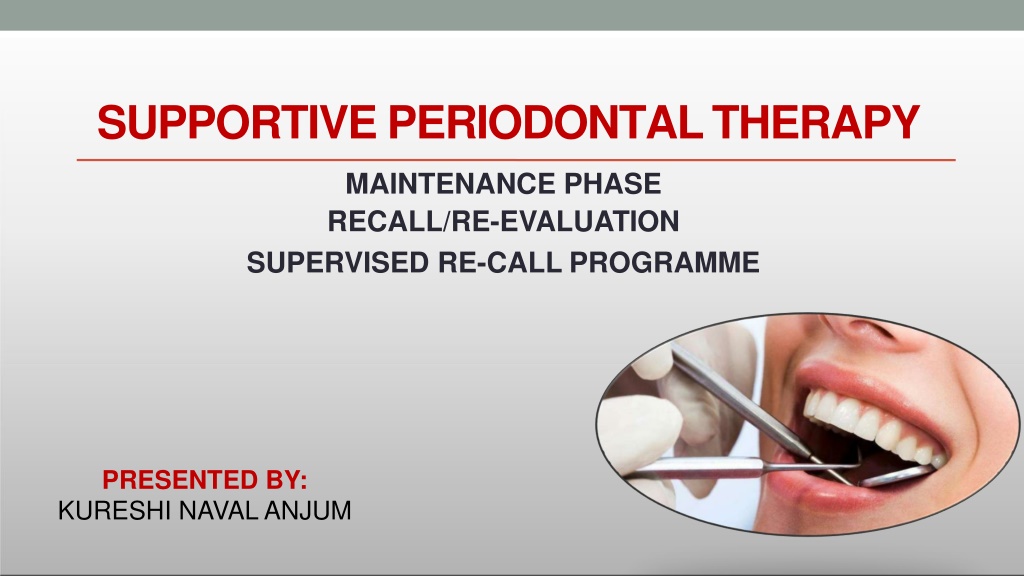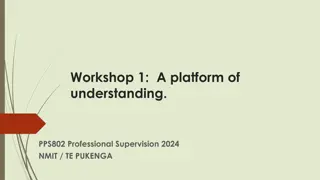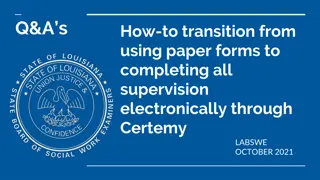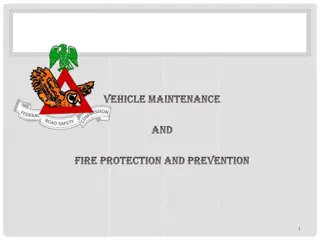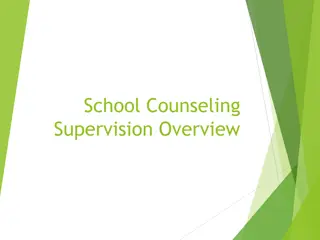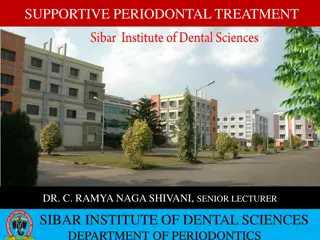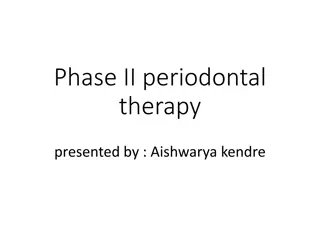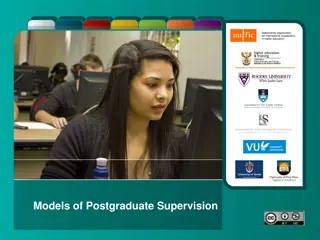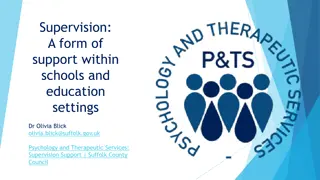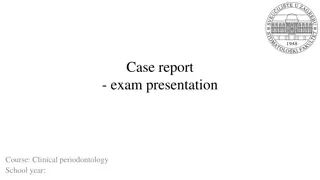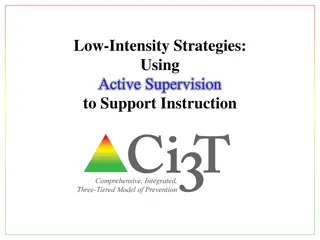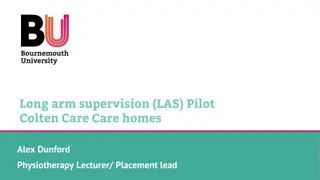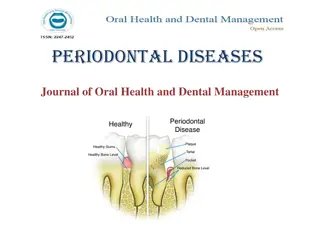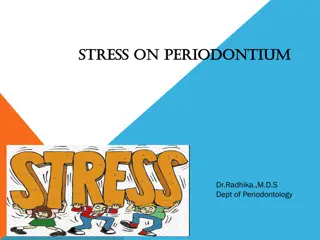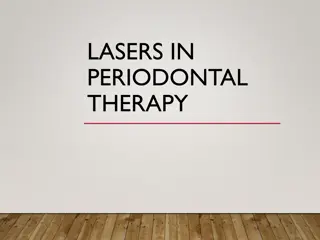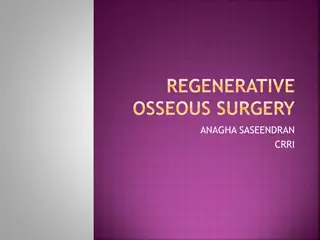Supportive Periodontal Therapy: Maintenance and Supervision Overview
Supportive Periodontal Therapy (SPT) is a critical phase in periodontal care designed to assist patients in maintaining oral health, prevent disease recurrence, and preserve bone support. It involves a series of procedures performed at intervals to support the patient's efforts in controlling and avoiding reinfection. The goals, objectives, types, and maintenance program of SPT outlined in this content provide a comprehensive understanding of this essential aspect of periodontal treatment.
Download Presentation

Please find below an Image/Link to download the presentation.
The content on the website is provided AS IS for your information and personal use only. It may not be sold, licensed, or shared on other websites without obtaining consent from the author. Download presentation by click this link. If you encounter any issues during the download, it is possible that the publisher has removed the file from their server.
E N D
Presentation Transcript
SUPPORTIVEPERIODONTALTHERAPY MAINTENANCE PHASE RECALL/RE-EVALUATION SUPERVISED RE-CALL PROGRAMME PRESENTED BY: KURESHI NAVAL ANJUM
DEFINITION Procedures performed at selected intervals to assist the periodontal patient in maintaining oral health.-GPT 2001. Therapeutic measures to support the patient s own efforts to control and to avoid re infection.- Jan Lindhe.
RATIONALE FOR SPT 1. Limitation of mechanical subgingival debridement 2. Recolonization of pocket 3. Long JE (weak attachment) 4. Subgingival scaling alters the microflora of periodontal pockets 5. To prevent interception
GOALS OF SPT 3 main goals according to theAAP position paper (1998) 1) To prevent or minimize the recurrence and progression of periodontal disease in patients who have been previously treated for gingivitis, periodontitis and for peri-implantitis. 2) To prevent or reduce the incidence of tooth loss by monitoring the dentition 3) To locate and treat other diseases or conditions found in the oral cavity in a timely manner
OBJECTIVES OF SPT Periodontal Preservation of bone support Maintenance of stable CAL. Reinforcement of proper home care. Maintenance of a healthy and functional oral environment General Assessment of the general health status Encouragement of patients oral hygiene efforts Continuation of patient education Establishment of the future maintenance regime
Schallhorn and Snider (1981) TYPES OF SPT Preventive maintenance therapy Periodontally healthy individuals. Trial maintenance therapy Mild to moderate periodontitis Compromised maintenance therapy Medically compromised patients where active therapy is not possible. Post-maintenance treatment therapy maintenance for prevention of recurrence of disease 1. 2. 3. 4.
MAINTENANCE PROGRAM (CARRANZA) 1. Examination and Evaluation (14 mins.) 2. Maintenance Rxand oral hygiene reinforcement (36 mins.) SPT 3. Report, Cleanup, and Scheduling (10 mins.)
PART- 1: EXAMINATION AND EVALUATION Patient greeting Medical history changes Oral hygiene status Gingival changes Pocket depth changes Mobility changes Occlusal changes Dental caries Oral pathologic examination Restorative, prosthetic, and implant status Examination of prosthesis/abutment components; Evaluation of implant stability; Occlusal examination; Other signs and symptoms of disease activity.
RADIOGRAPHIC EXAMINATION OF RECALL PATIENTS Clinical caries or high-risk factors for caries Posterior bite-wing examination at 12 to 18-month intervals. dental implants Periodontal disease not under good control. Root form Periapical and/or vertical bite-wing radiographs of problem areas every 12 to 24 months; full-mouth series every 3 to 5 years Periapical or vertical bite-wing radiographs at 6, 12, and 36 months after prosthetic placement, then every 36 months unless clinical problems arise. History of periodontal treatment with disease under good control. Clinical caries and no high-risk factors for caries. Posterior bite-wing examination at 24 to 36-month intervals. Bite-wing examination every 24 to 36 months; full- mouth series every 5 years.
MICROBIAL TESTING
PART-2: MAINTENANCE TREATMENT AND ORAL HYGIENE REINFORCEMENT Oral hygiene reinforcement Scaling Polishing Chemical irrigation or site-specific antimicrobial placement
PART-3: REPORT, CLEANUP, AND SCHEDULING Write report in chart. Discuss report with patient. Clean and disinfect operatory. Schedule next recall visit. Schedule further periodontal treatment. Schedule or refer for restorative or prosthetic treatment.
FREQUENCY OF SPT Ramfjord et al. (1993) For most patients with gingivitis but no previous attachment loss, supportive periodontal treatment twice a year. For patients with a previous history of periodontitis, 3 months interval (less than 6 months) Various clinical trails suggest- four times a year.
EFFECTIVENESS OF SPT (FOR PATIENTS WITH GINGIVITIS) Axelsson and Lindhe (1974-1976): demonstrated that gingivitis could be prevented by regular professional cleaning in children aged 7 to 14 years. Axelsson and Lindhe (1981): reduced caries and BOP Badersten et al.(1990): Routine mechanical subgingival debridement of shallow bleeding sites at SPT visits results in attachment loss.
Gingival conditions improved by 60% and tooth loss was reduced by about 50% (Lovdal et al. 1961) The mean loss of probing attachment was only 0.08 mm per surface as opposed to 0.3 mm in the control group (Suomi et al. 1971).
EFFECTIVENESS OF SPT (FOR PATIENTS WITH PERIODONTITIS) Nyman et al. (1977) reported on 25 patients for 2 years (No SPT) Regular SPT at 3-4 times a year allows disease monitoring Early detection and Rx Nyman et al. (1975) Test Control OHI and SPT 6 months OHI and SPT 2 weeks
Dahlen et al. (1992) Professionally delivered supragingival toothcleaning, in combination with self-performed plaque control for 2-year period effectively change the quantity and the composition of the subgingival microbiota Hellstrom et al. (1996) same protocol has a significant effect on the subgingival microbiota of moderate to deep periodontal pockets clinically.
(Lindhe & Nyman 1984) 75 patients with extremely advanced periodontitis, recurrent infection occurred in only very few sites during a 14 year period of effective SPT. recurrent periodontitis was noted at completely unpredictable time intervals, in about 25% of the patient population (15 of 61)
30YEARS PLAQUECONTROL-BASED MAINTENANCE PROGRAM Axelsson et al. 2004 375 test and 180 control The test group- prophylactic visits every second month for the first 2 years and every 3 12 months (according to their individual needs) over 3 30 years very few teeth were lost (0.4 1.8) 1.2 2.1 new carious lesions (>80% secondary caries) 2 4% of all sites exhibited attachment loss of 2 mm.
COMPLIANCE AFFECTING SPT Wilson stated that Patients who comply to suggested recall visits are periodontally healthy and keep their teeth longer.
IMPROVING COMPLIANCE Wilson suggests: Counselling them about their condition, the role of treatment and the importance of compliance Simplify instructions to patients Teach them self performed plaque control Acccommodating patient needs Positive reinforcement
MAINTENANCE OF IMPLANTS Lang et al. 2004, Cumulative Interceptive supportive Therapy
MAINTENANCEINTERVALSFORIMPLANTPATIENTS 1. Patients with both teeth and implants should see the periodontist as often as necessary to keep the periodontium and peri-implant tissues healthy. 2. Totally edentulous patients with implants should be seen at least once per year.
Conclusionand recommendations SPT should be based on profile of risk assessment No scientific evidence for subgingival debridement of sites with BOP without concomitant increase in pocket depth. (it should better be avoided) SPT minimizes the risk of periodontal disease progression and tooth mortality In absence of long-term evaluation of SPT for dental implants, same principles of SPT that is used for periodontitis is also apropriate
RECOMMENDATION FOR RESEARCH Studies are needed: 1. to evaluate the efficacy of supragingival Rx alone as compared to subgingival debridement 2. To assess the value of antibiotics as adjunct and stand alone Rx during SPT 3. Patient based factors must be considered in analysis 4. Prospective and multicenter studies to findout efficacy of SPT
Incterceptives SPT
REFRENCES: AmericanAcademy of Periodontology. Glossary of PeriodontalTerms. 4th ed. Chicago:AmericanAcademy of Periodontology; 2001. p. 39. Kerry GJ. Supportive periodontal treatment. Periodontology 2000, vol. 9, 1995, 176-185. Renvert S. Supportive periodontal therapy. Periodontology 2000, vol. 36, 2004, 179 195. Hancock EB. Preventive strategies and supportive treatment. Periodontology 2000, vol. 25, 2001, 59 76. WilsonTG Jr. Supportive periodontal treatment introduction - definition, extent of need, therapeutic objectives, frequency and efficacv. Periodontology 2000, vol. 12, 1996, 11-15. Slots J. Microbial analysis in supportive periodontal treatment. Periodontology 2000. Voz. 12, 1996, 56-59. FarooqiAO.Appropriate recall interval for periodontal maintenance:A systematic review. J evid base dent pract 2015;15:171-181.
